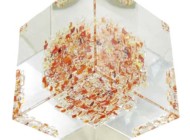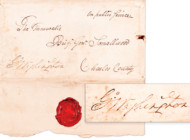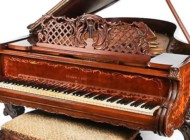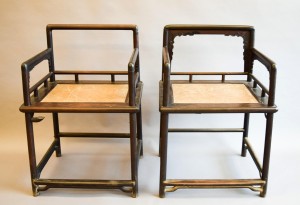
Topping the day was a pair of Tzutan Seventeenth Century rose chairs that brought $24,750. The pair of chairs, with caned seats, were in untouched condition and one had the original interior cloud-carved aprons intact.
Review by Rick Russack, Catalog Photos Courtesy Tremont Auctions
NEWTON, MASS. — Tremont’s October 16 Asian sale, which grossed more than $800,000, proved that buyers know what they want and estimates were routinely exceeded. Topping the day was a pair of Tzutan Seventeenth Century rose chairs that brought $24,750.
Two other items finished slightly behind the chairs. A Chinese Eighteenth–Nineteenth Century rosewood table with a 25½-inch-square decorated porcelain plaque inlaid sold for $22,300 and a finely cast, Thirteenth Century bronze throne for an image, from Nepal, brought more than nine times its estimate, finishing at $23,400. The expected top lot of the day, an inscribed Fifteenth Century gilt-bronze figure of Vajrasattva, was bid to $134,550, slightly under its reserve, but sold after the sale for a negotiated price.
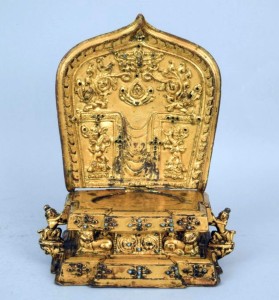
One of the unexpected top lots in the sale was this Nepalese Thirteenth Century gilt bronze throne for an image. Two human figures flanked a lion throne and its final price was $23,400.
The sale included an assortment of Asian porcelain and pottery, several examples of Japanese mixed metal objects, numerous pieces of carved jade and stone, carved wood and bronze statues of buddha, cloisonné, snuff bottles and much more. Many lots drew multiple bidders. There were about 75 bidders in the room, several phone lines were in use and internet bidding was available on three platforms.
The pair of Seventeenth Century chairs that sold for $24,750 had caned seats, were in untouched condition and one had the original interior cloud-carved aprons intact. They came from a descendant of William Keeney Bixby, who spent much time in China following the Boxer Rebellion, and put much of his collection together about that time, circa 1905.
Bixby was a wealthy St Louis businessman who served as president of the American Car and Foundry Company, retiring at the age of 48 to pursue his many collecting interests, which included books, manuscripts and fine art, along with Chinese antiques. He was considered one of the city’s wealthiest residents and was involved with the establishment of the Saint Louis Art Museum and other institutions. Several of the items in the Tremont sale were from the Bixby collection. Interestingly, at the time the collection was assembled, anti-foreigner sentiment was strong in China. Few Occidentals had scholarly knowledge of fine Chinese antiques, so its likely that high-ranking Chinese citizens assisted him collecting items of the quality he was able to obtain.
One of the most interesting items in the sale fell just short of its reserve but did sell a few days after the auction. The gilt-bronze image of Vajrasattva with the mark of Yung Lo (1402–1424) was cataloged as being from the period. Inscribed in Chinese, “Bestowed during the Yung Lo era,” the seated figure on a double lotus throne, with jewels, was holding a vajra and a flower. It was 9 inches tall, with traces of cold gold paste on the face and blue pigment in the hair.
Jim Callahan, Tremont’s vice president, Antiques Roadshow appraiser and Asian scholar, said the bronze had been given by the Chinese emperor to Tibet’s Dali Lama about 1420 as part of a goodwill campaign following the establishment of the Ming dynasty in 1368. Bidding reached $115,000 ($134,550, with buyer’s premium) but failed to meet the reserve, presumably near the low estimate of $150,000. The final selling price remains confidential.
The large rosewood and porcelain table was an important example of Chinese porcelain making skills. The Nineteenth Century rosewood
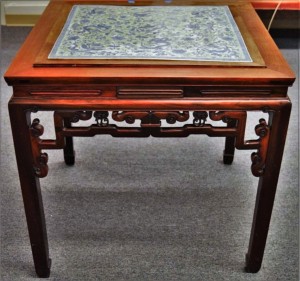
With a 25½-inch-square inset porcelain plaque, this Chinese rosewood table sold for $22,230. The porcelain was dated as Eighteenth or Nineteenth Century and the table itself was later.
table was inset with a large Eighteenth–Nineteenth Century porcelain plaque, decorated in underglaze blue on a lime green ground with nine dragons, all different, and each clutching floral vines. The plaque was 25½ inches square and perhaps a half-inch thick. Creating a single piece of porcelain that size was a very difficult undertaking at the time and it is unlikely that European porcelain factories were capable of producing something that size. Callahan thought that the top would be removed from the table, framed, and hung on a wall. A marble slab could easily be inset into the rosewood table frame. The table sold for $22,230.
The sale included several examples of Japanese Meiji period (1868–1912) mixed metal vases, platters and other forms. Topping the group was a pair of pear-shaped vases inlaid with pepper plants in red, along with gold, shakudo, a low gold content alloy, and copper. The pair was 8 inches tall, signed, and sold for $9,360. A pair of bronze vases, 9½ inches tall, with mixed metal inlays in the form of cucumbers, butterflies and vines, reached $2,574. An 11-inch bronze mixed metal vase, decorated with a hoopoe bird in an autumn tree, with inlays of gold and shakudo, achieved $1,755. All had come from one collection. The artistry of mixed metal work in Japan grew out of the tradition of making elaborate sword fittings, when, in 1876, samurai were banned from carrying swords.
There were several pieces of Chinese porcelain in the sale, much of it having been made for the export market. A porcelain ewer from China’s transitional period (1621–24) clearly showed the influence of foreign markets. It was decorated in underglaze blue, with a scene of a scholar and his attendant in a landscape. The neck of the ewer was decorated with a tulip, most likely indicating that it had been made for the Dutch market, being served by merchants of the Dutch East India Company which had been formed in 1602. It realized $3,042. A large Nineteenth Century fish bowl, with famille rose decoration of dragons and clouds, 17½ inches deep, and a Tao Kuang mark on the base finished at $3,042. A porcelain bowl with a Kuang Hsu mark (1875–1908) with underglaze blue decoration of the Immortals, a central reserve of Shao Lao and a deer, achieved $5,850, more than ten times the estimate.
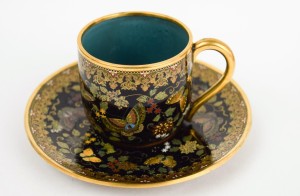
Namikawa Yasuyuki was one of Japan’s most accomplished cloisonné artists during the Meiji period. This finely decorated cup and sauce is signed on the handle, and earned $19,890.
From the Bixby estate, an early polychrome tou tsai ware 6¼-inch saucer, K’ang hsi period (1662–1722) with a Ch’eng Hua mark, decorated with the San Duo, around a central reserve of a pomegranate tree fetched $2,340, regardless of chips and hairline cracks. A rather ordinary small yellow bowl with a Kuang Hsu mark (1875–1908) and decorated with bats, peaches, Shou medallions and ju-i sold for $585. It was a gift from the Empress Dowager Cixi to Sarah Conger, wife of Edwin Conger, American ambassador to China. When Callahan was asked why such an ordinary looking bowl would have been a gift from the empress dowager to a high-ranking American, he explained that the empress was virulently anti-American and probably considered that this “gift” was, in fact, an insult, which of course would not have been understood by the ambassador’s wife.
An exceptional Japanese Meiji period cloisonné cup and saucer, signed on the handle by Namikawa Yasuyuki, with fine gold and silver wire decoration of butterflies and flowers reached $19,890. Yasuyuki (1845–1927) was, perhaps, the greatest cloisonné artist in Japan and was honored as an Imperial Household Artist. The Namikawa Cloisonné Museum in Higashiyama-ku, Kyoto, exhibits his works, which are also in a number of other major museum collections.
A Japanese Meiji period cloisonné vase, 6¼ inches tall decorated with wisteria and cherry blossoms on a midnight blue ground, made $1,872. A Seventeenth Century Chinese cloisonné bowl, 9½ inches, decorated with gourd plants on a turquoise ground fetched $1,872, while a pair of round Twentieth Century Chinese cloisonné vases, 9 inches tall, decorated with scrolling lotus vines, went for $1,755.
A pale celadon green, Chinese jade covered jar from the late Nineteenth Century, well carved with flowering trees and a chain joining the
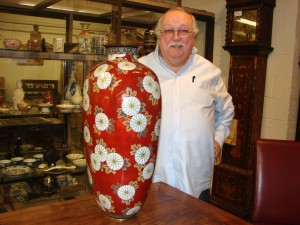
Jim Callahan, vice president of Tremont Auctions, is an Asian arts scholar and expert in Asian decorative arts. He put the sale together and did much of the cataloging.
cover to the jar, more than doubled its estimate, attaining $4,914. A Chinese Ch’ien Lung period (1735–96), archaic-style jade censer brought $11,170. The jade was a highly translucent celadon, it had dragon handles, the surface was carved with taotie masks and it had a carnelian finial. A Nineteenth Century jade rhyton of white stone with black markings and carved with scrolling swirls achieved $8,190.
The sale included numerous other interesting items. A Chinese officer’s sword from the early Republican period, prior to 1935, more than doubled its estimate, bringing $11,700, probably because of its historical association. The steel chrome plated blade was engraved with seven characters and foliate scrolling. The scabbard had lion-shaped hangers and was decorated with Republican flags, clouds and flowers. It may have belonged to General Chang Ching Yao, a notoriously cruel and corrupt governor of the Hunan Province who allowed his troops to rape and pillage the province while becoming very wealthy. He was assassinated in 1933. The sword was consigned by descendants of a US Navy veteran who was stationed in Japan and present at Japan’s surrender.
A particularly fine Peking enamel sweetmeat box, dating from the Ch’ien Lung period had a sky blue ground with polychrome decoration of butterflies, flowers and resonance stones around a central open flower. Although it had minor chipping, it sold for $6,435. An Eighteenth Century Chinese valuables chest was the subject of heavy bidding by three people in the sales room, two phone lines and the internet. A bidder in the room was finally successful, paying $11,115, more than nine times the estimate. Well carved wooden buddha statues are scarcer than bronze ones. Early in the sale, a carved wood Ch’ien Lung period seated figure of Shadakshari Lokeshvara sold for $17,550 and another, of a seated figure wearing jewels, sold for $14,040. Both were from the Bixby collection and both had been estimated at a high of $1,200.
Doug Stinson, one of the owners of Tremont, discussed some of the in-house procedures involved with being confident that online bidders were serious. For this sale, they used another internet platform, Artfox, a Chinese language platform that says it requires credit card deposits from prospective bidders, based on a percentage of the bids they wish to place. With bidders on and who are not known to Tremont, a $5,000 credit card deposit is required if the bidder is interested in high value lots. They may also require photocopies of driver’s licenses, passports, and both front and back of credit cards. Successful bidders have ten days to pay for their purchases. If payment has not been received, Tremont cancels the sale and may return items to consignors.
All prices reported include the buyer’s premium.
For additional information, www.tremontauctions.com or 617-795-1678.
[slideshow_deploy id=’1000277211′]
